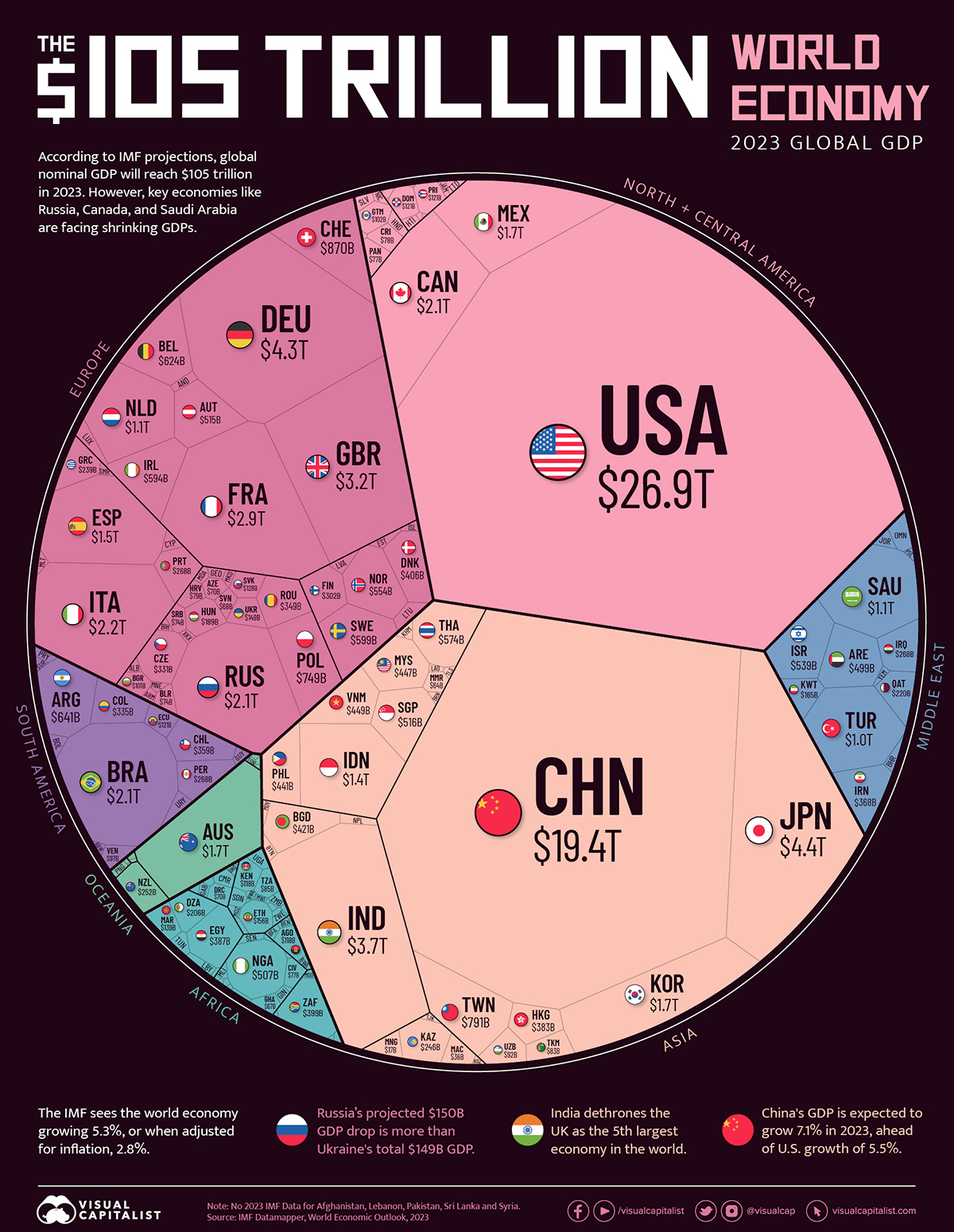Visual Capitalist: Visualizing The $105 Trillion World Economy In One Chart
Visualizing the $105 Trillion World Economy in One Chart
By the end of 2023, the world economy is expected to have a gross domestic product (GDP) of $105 trillion, or $5 trillion higher than the year before, according to the latest International Monetary Fund (IMF) projections from its 2023 World Economic Outlook report.
In nominal terms, that’s a 5.3% increase in global GDP. In inflation-adjusted terms, that would be a 2.8% increase.
The year started with turmoil for the global economy, with financial markets rocked by the collapse of several mid-sized U.S. banks alongside persistent inflation and tightening monetary conditions in most countries. Nevertheless, some economies have proven to be resilient, and are expected to register growth from 2022.
Ranking Countries by Economic Size in 2023
The U.S. is expected to continue being the biggest economy in 2023 with a projected GDP of $26.9 trillion for the year. This is more than the sum of the GDPs of 174 countries ranked from Indonesia (17th) to Tuvalu (191st).
China stays steady at second place with a projected $19.4 trillion GDP in 2023. Most of the top-five economies remain in the same positions from 2022, with one notable exception.
India is expected to climb past the UK to become the fifth-largest economy with a projected 2023 GDP of $3.7 trillion.
Here’s a look at the size of every country’s economy in 2023, according to IMF’s estimates.
Note: Projections for Afghanistan, Lebanon, Pakistan, Sri Lanka and Syria are missing from IMF’s database for 2023.
Here are the largest economies for each region of the world.
- Africa: Nigeria ($506.6 billion)
- Asia: China ($19.4 trillion)
- Europe: Germany ($4.3 trillion)
- Middle East: Saudi Arabia ($1.1 trillion)
- North & Central America: U.S. ($26.9 trillion)
- Oceania: Australia ($1.7 trillion)
- South America: Brazil ($2.1 trillion)
Ranked: 2023’s Shrinking Economies
In fact, 29 economies are projected to shrink from their 2022 sizes, leading to nearly $500 billion in lost output.

Russia will see the biggest decline, with a projected $150 billion contraction this year. This is equal to about one-third of total decline of all 29 countries with shrinking economies.
Egypt (-$88 billion) and Canada (-$50 billion) combined make up another one-third of lost output.
In Egypt’s case, the drop can be partly explained by the country’s currency (Egyptian pound), which has dropped in value against the U.S. dollar by about 50% since mid-2022.
Russia and Canada are some of the world’s largest oil producers and the oil price has fallen since 2022. A further complication for Russia is that the country has been forced to sell oil at a steep discount because of Western sanctions.
Here are the projected changes in GDP for all countries facing year-over-year declines:
The presence of Saudi Arabia, Norway, Kuwait, and Oman in the top 10 biggest GDP contractions further highlights the potential impact on GDP for oil-producing countries, according to the IMF’s projections.
More recently, producers have been cutting supply in an effort to boost prices, but concerns of slowing global oil demand in the wake of a subdued Chinese economy (the world’s second-largest oil consumer), have kept oil prices lower than in 2022 regardless.
The Footnote on GDP Forecasts
While organizations like the IMF have gotten fairly good at GDP forecasting, it’s still worth remembering that these are projections and assumptions made at the beginning of the year that may not hold true by the end of 2023.
For example, JP Morgan has already changed their forecast for China’s 2023 real GDP growth six times in as many months after expectations of broad-based pandemic-recovery spending did not materialize in the country.
The key takeaway from IMF’s projections for 2023 GDP growth rests on how well countries restrict inflation without stifling growth, all amidst tense liquidity conditions.
Where Does This Data Come From?
Source: The International Monetary Fund’s Datamapper which uses projections made in the April 2023 World Economic Outlook report.
Note: Projections for Afghanistan, Lebanon, Pakistan, Sri Lanka and Syria are missing from the IMF’s database. Furthermore, all figures used in the article, unless specified, are nominal GDP numbers and rates.
Source: https://www.visualcapitalist.com/visualizing-the-105-trillion-world-economy-in-one-chart/















